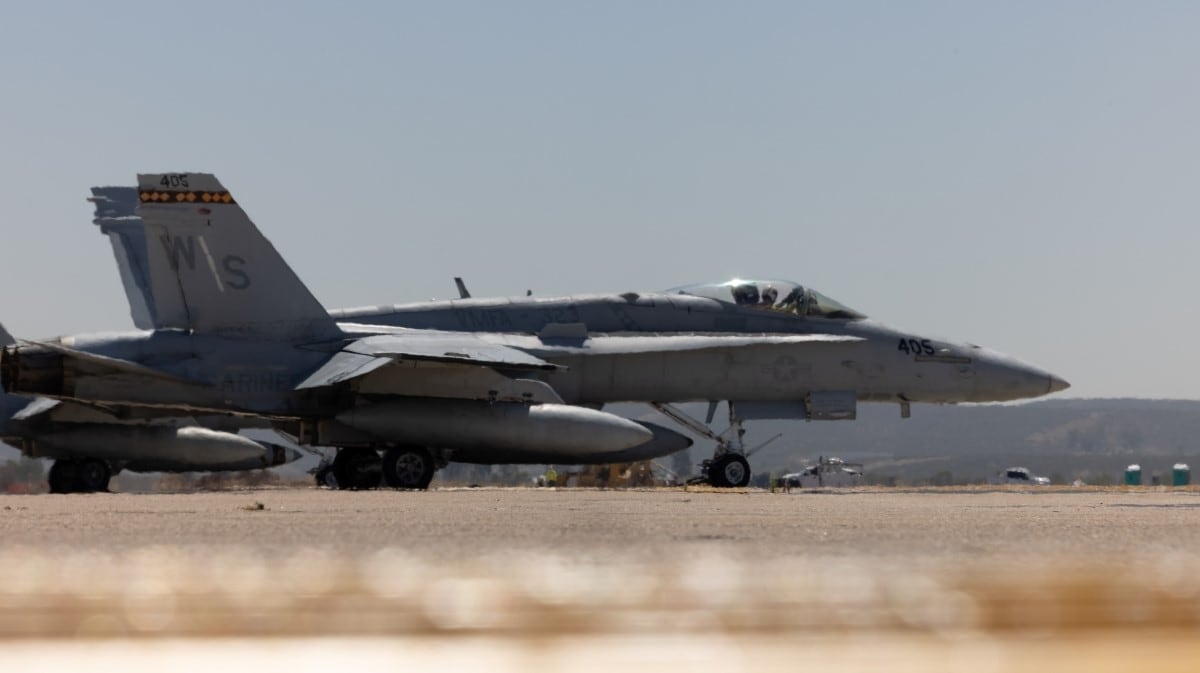A Marine Corps fighter jet had a close call in September with a private jet in Texas, prompting the private aircraft to take “evasive action,” according to the Federal Aviation Administration.
At around noon on Sept. 23, the pilot of a Cessna Citation business jet at Austin-Bergstrom International Airport received an “onboard alert” that the single-seat F/A-18C Hornet fighter jet was close by, the FAA said in a Thursday emailed statement to Marine Corps Times. It’s unclear exactly what the pilot of the private jet did in response to that alert.
That same day, the F/A-18 also flew close to a different civilian aircraft that was preparing for takeoff, according to the FAA.
Archived radio traffic indicates an air traffic controller in Austin was not clear about what the military jet’s pilot intended to do.
The Cessna private jet had been cleared to land as the F/A-18 approached the airport, according to The Washington Post, which broke the news of the close call. The fighter jet received permission from air traffic control to execute a break, which involves turning sharply to slow down before landing, the Post reported.
In a recording of the air traffic control radio obtained by the local ABC affiliate KVUE, an air traffic controller at the Texas airport can be heard expressing surprise at the Marine pilot’s descent, after another voice says, “That’d have been nice to know, guy.”
“I requested opposite air speed at my discretion before the break,” the F/A-18 pilot, with the callsign Snake 2-1, can be heard saying. “Misunderstanding, I suppose.”
After landing, the F/A-18 pilot asked for a phone number to contact the air traffic control office, and a controller replied, “Yeah, I was going to give you the number here because I guess there was a miscommunication. I misunderstood what was requested, I guess,” according to the Post.
The FAA said it is investigating the incident, including how close together the aircraft came. The administration’s safety experts follow up on “all events,” even when a collision wasn’t imminent or even possible, according to the FAA.
The F/A-18 also “conflicted” with another civilian aircraft, flying near a runway while a small Piper PA-28 was preparing for takeoff, according to the FAA.
The fighter jet came from Marine Fighter Attack Squadron 323, which is based out of Marine Corps Air Station Miramar, California, Marine spokeswoman Capt. Stephanie Leguizamon said Thursday via email to Marine Corps Times.
As of a few days after the Sept. 29 deactivation of the Marine Corps’ only F/A-18 training squadron, Marine Fighter Attack Squadron 323 is home to both seasoned and student F/A-18 pilots, Leguizamon said. But that transition took place more than a week after the close call.
The squadron had been involved in routine training in the Brownwood Military Operating Area northwest of Austin and was doing refueling operations at Austin-Bergstrom Airport, according to Leguizamon.
“A preliminary assessment of the event at the Austin-Bergstrom airport indicates that the pilot complied with air traffic control direction,” Leguizamon said.
The Marine Corps is cooperating with the FAA and is investigating the incident itself, the Marine spokeswoman added.
The incident was the third known close call in 2023 at Austin-Bergstrom Airport, in the Texas capital.
In June, an Allegiant Air flight came within 200 feet of a small aircraft, KVUE reported. In February, a FedEx cargo plane and a Southwest Airlines jet carrying 128 people were seconds away from colliding because of an apparent mistake by an air traffic controller, according to The New York Times.
A New York Times investigation in August found close calls involving commercial airlines were happening, on average, multiple times a week, often because of mistakes by understaffed air traffic control. But there hasn’t been a fatal plane crash involving a major U.S. airline since 2009, the outlet reported.
“One close call is one too many,” the FAA said in the statement to Marine Corps Times. “The FAA and the aviation community are pursuing a goal of zero serious close calls, a commitment from the Safety Summit in March.”
The FAA said it relies on several layers of anti-collision measures, including commercial aircrafts’ collision avoidance systems, runway surface safety technology at big airports and “robust procedures.”
“Air traffic controllers and pilots also play critical roles,” the FAA said.
Irene Loewenson is a staff reporter for Marine Corps Times. She joined Military Times as an editorial fellow in August 2022. She is a graduate of Williams College, where she was the editor-in-chief of the student newspaper.





